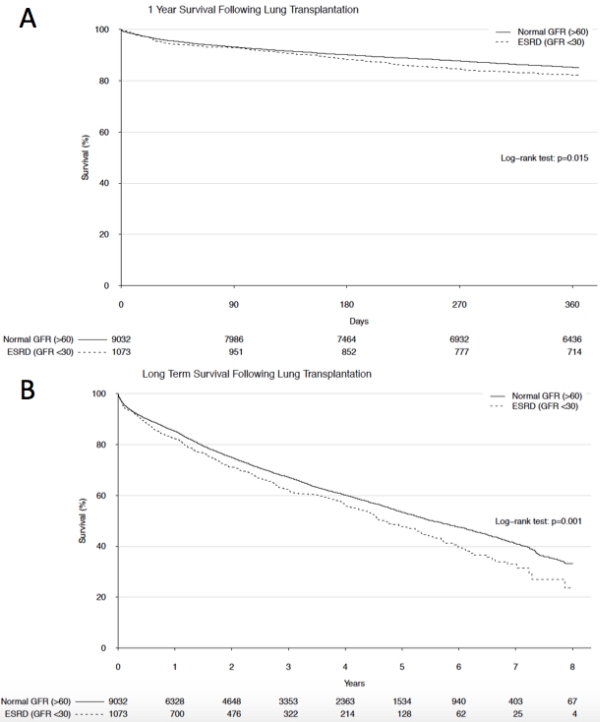Lung Transplantation from Donors With Kidney Disease
Duke University Medical Center, Durham, NC.
Meeting: 2015 American Transplant Congress
Abstract number: B206
Keywords: Donors, Lung transplantation, marginal, Survival
Session Information
Session Name: Poster Session B: Lung- All Topics
Session Type: Poster Session
Date: Sunday, May 3, 2015
Session Time: 5:30pm-6:30pm
 Presentation Time: 5:30pm-6:30pm
Presentation Time: 5:30pm-6:30pm
Location: Exhibit Hall E
Background:
Various donor characteristics are associated with decreased survival following single (SLT) or bilateral (BLT) lung transplantation. No current studies exist regarding use of lungs from patients with kidney disease (KD). Thus, the objective of the current study was to examine outcomes following lung transplantation from donors with KD.
Methods:
Query of the UNOS database identified all SLT and BLTs performed from 2005-2013. Redo, multi-organ, or pediatric transplants were excluded. Glomerular filtration rate (GFR) was calculated with UNOS creatinine data for patient group stratification: KD (GFR ≤ 30 ml/minute) and normal GFR (nGFR) (GFR > 60 ml/minute). The primary outcome was 1-year survival and secondary endpoints included overall survival and post-transplant length of stay. Kaplan-Meier analysis with the log-rank test and a Cox-proportional hazard model were used for survival analysis.
Results:
10,144 transplants were identified of which 1,079 (10.6%) were from KD donors. Use of KD donor organs increased from 6% in 2005 to 13% in 2011 (p<0.01). KD donors were older (median age: 38 vs 30 years), more commonly had diabetes (20% vs 4%), and were more commonly African-American (30% vs 17%) (all p<0.01). Recipients of KD donors were older (median age: 60 vs 58; p<0.01), but were otherwise similar to recipients of nGFR donors. No significant difference in lung allocation score (median: 39 vs 39; p=0.50) or waitlist time (p=0.15) existed. Unadjusted survival was lower in the KD group at 1 year (82.4% vs 85.2%) and long-term (Figure). However, following adjustment, this difference failed to remain significant (1 year: hazard ratio-1.17; p=0.07; long term: hazard ratio-1.10; p=0.09). No difference was noted in postoperative length of stay (p=0.27).
Conclusions:
Use of lungs from donors with KD when compared to nGFR donors potentially portends a worse survival. However, as evidenced by advanced donor age and incidence of diabetes, KD donors often have other comorbidities that may also play a role. Continued careful expansion of the donor pool by using pulmonary allografts from KD donors is appropriate, but further study of use of these lungs is warranted.

To cite this abstract in AMA style:
Ganapathi A, Gulack B, Castleberry A, Davis R, Snyder L, Hartwig M. Lung Transplantation from Donors With Kidney Disease [abstract]. Am J Transplant. 2015; 15 (suppl 3). https://atcmeetingabstracts.com/abstract/lung-transplantation-from-donors-with-kidney-disease/. Accessed January 7, 2026.« Back to 2015 American Transplant Congress
